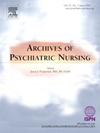Implementation of screening, brief intervention, and referral to treatment (SBIRT) utilizing the CRAFFT+N among pediatric patients at an outpatient psychiatric practice
IF 2.2
4区 医学
Q1 NURSING
引用次数: 0
Abstract
Background
Substance use among adolescents poses a significant public health challenge, with escalating rates over recent decades contributing to preventable morbidity and mortality. Despite its prevalence, only a fraction of affected individuals receive intervention, emphasizing the need for comprehensive healthcare strategies. The CRAFFT is a common tool used to evaluate substance use in youths, but limited studies have examined the innovative CRAFFT+N, which includes a nicotine screen. Thus, this study aimed to evaluate the feasibility and fidelity of pediatric SBIRT in an outpatient psychiatric setting through retrospective chart review, and secondary aims were to explore rates of pediatric substance use and associations with psychiatric variables and modality of visits, in addition to trends over time.
Methods
A retrospective chart review of electronic health record data was completed. Chi-squared analyses were used to compare which psychiatric diagnoses and psychotropic medications were associated with positive CRAFFT+N scores.
Results
A total of 455 patient encounters were reviewed, revealing concerning rates of substance and nicotine use, with approximately 20 % screening positive on the CRAFFT+N. Depressive disorders (p < 0.001), OCD (p = 0.012), and neurodevelopmental disorders (p = 0.015) were associated with positive CRAFFT scores. Positive nicotine scores were associated with bipolar disorders (p < 0.001), psychotic disorders (p = 0.001), and other psychiatric disorders (p = 0.039). Mood stabilizers were the only medication class associated with positive CRAFFT+N scores (both p < 0.001).
Conclusions
The new CRAFFT+N tool can be used to implement SBIRT into the workflow in an outpatient setting interested in assessing substance use in those aged 12–21 years.
利用craft +N在门诊精神科儿科患者中实施筛查、短暂干预和转诊治疗(SBIRT)
青少年药物使用是一项重大的公共卫生挑战,近几十年来使用率不断上升,造成了可预防的发病率和死亡率。尽管它的流行,只有一小部分受影响的个人接受干预,强调需要全面的卫生保健战略。craft是一种用于评估青少年药物使用情况的常用工具,但对创新的craft +N进行了有限的研究,其中包括尼古丁屏幕。因此,本研究旨在通过回顾性的图表回顾来评估儿科SBIRT在门诊精神科环境中的可行性和保真度,次要目的是探讨儿童药物使用率及其与精神科变量和就诊方式的关系,以及随时间的趋势。方法对电子病历资料进行回顾性图表分析。采用卡方分析比较精神病学诊断和精神药物与kraft +N阳性评分的相关性。结果共审查了455例患者,揭示了有关物质和尼古丁使用的比率,约20%的患者在craft +N筛查中呈阳性。抑郁症(p <;0.001)、强迫症(p = 0.012)和神经发育障碍(p = 0.015)与craft评分阳性相关。尼古丁评分阳性与双相情感障碍相关(p <;0.001)、精神障碍(p = 0.001)和其他精神障碍(p = 0.039)。情绪稳定剂是唯一与craft +N阳性评分相关的药物类别(p <;0.001)。结论新的craft +N工具可用于在对评估12-21岁人群药物使用感兴趣的门诊环境中实施SBIRT工作流程。
本文章由计算机程序翻译,如有差异,请以英文原文为准。
求助全文
约1分钟内获得全文
求助全文
来源期刊
CiteScore
3.70
自引率
0.00%
发文量
131
审稿时长
160 days
期刊介绍:
Archives of Psychiatric Nursing disseminates original, peer-reviewed research that is of interest to psychiatric and mental health care nurses. The field is considered in its broadest perspective, including theory, practice and research applications related to all ages, special populations, settings, and interdisciplinary collaborations in both the public and private sectors. Through critical study, expositions, and review of practice, Archives of Psychiatric Nursing is a medium for clinical scholarship to provide theoretical linkages among diverse areas of practice.

 求助内容:
求助内容: 应助结果提醒方式:
应助结果提醒方式:


